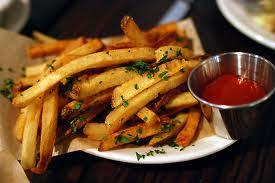Craving a big, fluffy hunk of warm bread does not mean your body is deprived of grains. Food cravings have little to do with nutrients and plenty to do with the brain chemistry of pleasure and reward. Cravings may center on texture( creamy, crunchy) or taste( sweet, salty) but they all have something in common- overindulging can sabotage your diet.
ICE CREAM
People who get cravings tend to have higher BMIs- no surprise since fattening foods are often the object of desire. The combination of coll, creamy and sweet makes ice cream an irresistible treat- but a costly one in terms of calories. A typical serving of vanilla has 230 calories
POTATO CHIPS
It's the combination of salty and crunchy that give potato chips their allure. Depending on the flavor, a 1-ounce snack bag has at least 150 calories. Munch your way through a large 8-ounce bag and you're looking at 1,230 calories!
CHOCOLATE
Almost half of women crave chocolate on a regular basis. There have been many theories to explain why, ranging from magnesium deficiency to mood swings. But one thing is certain: Consuming a chocolate bar is a quick way to add a couple hundred extra calories to your day.
POPCORN
Sometimes a setting can trigger a craving, like the desire for popcorn at the movies. Memory pllays a big role in cravings- you've enjoyed popcorn at the movies before, so you expect to enjoy it again. Popcorn itself can be a healthy snack. But movie theaters tend to pop it in coconut oil with buttery sauce. The result: 400 to 1,200 calories per tub!
STREET & PARK FOOD
Watching a game or just strolling in the park is not the same without a hotdog or nachos or peanuts. Just seeing or smelling the concession stands can make it tough to resist. But consider these numbers:
8 ounces of cheesy nachos-900 calories
8-ounce bag of raw peanuts-800 calories
Hotdog on a stick-400 calories
DOUGHNUTS
If you're on a diet, doughnuts are like the forbidden fruit. That fact alone may be enough to trigger a craving.
Doughnuts are an American favorite- from jelly filled to bear claws and those that are pink frosted or sprinkled. They're a sweet treat that people love but feel bad about eating. Unfortunately, the nutritional information of doughnuts is enough to make anyone think twice before taking a second serving- and sometimes even a first.
Doughnuts are high in calories which may contribute to weight gain. A 2-ounce doughnut has 220 calories. Most doughnuts however are at least 3 ounces or larger. Dunkin Donuts' website states that one of it's chocolate-frosted cake donuts has 340 calories, while one of it's jelly-filled donuts has 260. One doughnut, although usually not enough to make a person feel full on its own, has as many calories as one regular-sized, hearty breakfast.
RED MEAT
Do you feel like a meal is not a meal unless it involves a big chunk of meat? The good news is you don't have to give up meat to achieve a healthy weight- just be choosy about your cuts. A typical flank steak has about 700 calories.
PIZZA
Pizza is America's favorite food. It does have some health benefits: A typical slice has 12 grams of protein and 2.5 grams of fiber. But pizza also has about 280 calories a slice - more if you add meat toppings.
PASTA
Pasta ranks among the top five favorite foods in many countries. The trouble is most people eat white pasta, which is made with refined flour. White pasta has only a fifth the fiber of whole grain pasta, which means it may take more to fill you up. Pasta sauces can be diet-killers too. A large bowl of fettuccine Alfredo has 800 to 1,200 calories.
FRENCH FRIES
This salty side dish is hard to turn down when ordering at a drive-thru. But a large order of fries can have as many calories as a burger-about 500 at a typical fast food restaurant.
NUTS
Whether in a bar or party or strolling in the park, it's easy to keep dipping your hand into the nut bowl, but all those handfuls add up. A cupful of roasted nuts packs more than 800 calories.
COFFEE
Coffee craving may go beyond your typical food craving, thanks to the addictive powers of caffeine. You may feel you can't full wake up without your morning dose. Fortunately, coffee has very few calories- until you load it up with cream and sugar syrups. Large flavored lattes and mochas can have more than 400 calories.
COOKIES
Taking cookies for snacks is a very bad habit because cookies is high in sugar and much more in calories.









































